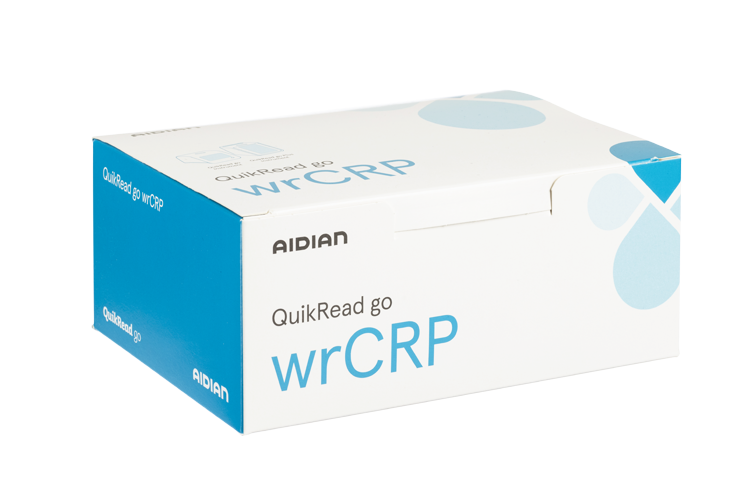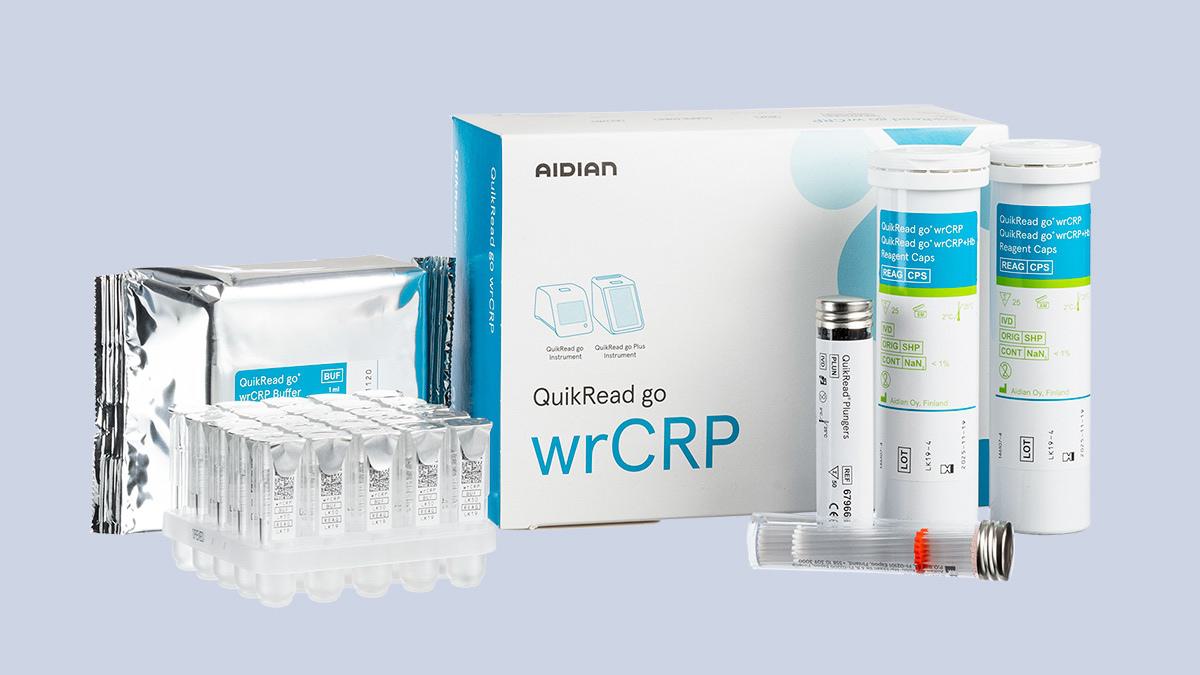QuikRead go wrCRP
QuikRead go wrCRP is a rapid test for the quantitative determination of C-reactive protein (CRP) values in whole blood, serum, and plasma with QuikRead go instrument. QuikRead go wrCRP gives reliable wide range CRP results within minutes.

Generally
Wide range CRP testing with QuikRead go wrCRP
C-reactive protein (CRP) is a widely used analyte to help assess the severity of bacterial infection, guide diagnostic and treatment decisions, and monitor response to antibiotic treatment in various healthcare settings1,2. QuikRead go wrCRP test helps to identify patients who benefit from antibiotics, it helps in monitoring the treatment outcome, and can be used to test for low level inflammation. CRP point of care testing drives sustainable use of antibiotics and antimicrobial stewardship in healthcare.

QuikRead go wrCRP has a wide measuring range, which covers for both high sensitive and conventional CRP tests. Modest increase in CRP levels within the high sensitivity range of 1-5 mg/l may indicate low level inflammation and aid in cardiovascular risk assessment3.
Easy sample collection
- A small sample volume (10 µl) approximates to a drop of blood
- Storage at room temperature up to +25 °C
- Finger prick or venous whole blood sample. Plasma or serum can also be used
Reliable wide range results within minutes
- Analysis time 2 minutes
- Wide CRP measuring range 0.5 - 200 mg/l* combines high sensitive and conventional CRP tests
- Enables detection of low level inflammation
Effortless testing with the QuikRead go multianalyte instrument
- Ready-to-use reagents
- Fully automated measurement
- Maintenance free
- Battery use ensures full portability
- Bi-directional connectivity to most HIS and LIS systems
*with whole blood and haematocrit of 40%, with plasma and serum 0,5 – 120 mg/l
Test results should never be used alone, without a complete clinical evaluation.
QuikRead go wrCRP is not registered in the USA.
References:
- Van Hecke O et al. Guidance on C-reactive protein point-of-care testing and complementary strategies to improve antibiotic prescribing for adults with lower respiratory tract infections in primary care. Front. Med 2023; 10:1166742.
- Bruns AH et al. Usefulness of consecutive C-reactive protein measurements in follow-up of severe community-acquired pneumonia. Eur Respir J 2008; 32(3):726-732.
- Emerging Risk Factors Collaboration. C-reactive protein concentration and risk of coronary heart disease, stroke, and mortality: an individual participant meta-analysis. Lancet 2010; 375:132-140.
Technical data
| Products available |
|
| Use | For in vitro diagnostic use, IVD CE |
| Method | Immunoturbidimetric |
| Sample type | Whole blood, serum, plasma |
| Instrument information | QuikRead go system instruments |
| Measurement time | 2 minutes |
| Reading of the result | Instrument read |
| Storage | 2 - 25 ºC |
| Size and weight | 190 x 140 x 80 mm / 0.507 kg |
| Additionally needed |
|
| Country of origin | Finland |
| Registration | Not registered in the USA |
| Registered trademark | QuikRead go is a registered trademark of Aidian Oy |
About C-reactive protein (CRP)
CRP aids clinical management of patients with infections or inflammatory conditions.
Learn more: About C-reactive protein
Antimicrobial resistance and CRP
Antimicrobial resistance is a global health threat. CRP point of care testing aids management of respiratory infections and fighting against antimicrobial resistance.
Learn more: Antimicrobial resistance and CRP
Documents and materials
Marketing and sales materials
QuikRead go wrCRP Brief Instructions (EN)
CRP Control Procedure Brief Instructions (EN)
QuikRead go Plus Family Brochure (EN)
QuikRead go Family Brochure (EN)
QuikRead go Plus Technical Specifications (EN)
QuikRead go Technical Specifications (EN)
Instructions for Fingertip Blood Collection (EN)
QuikRead go Control Information (EN)
QuikRead go workstation Flyer (EN)
The Benefits of CRP Point-of-Care Testing in General Practice (EN)
Instructions for use
(For informative use only. Kindly always refer to the latest package insert in the kit.)
QuikRead go wrCRP IFU (FI, SE, NO, DK), 146521, 146522
QuikRead go wrCRP IFU (GB, DE, FR, IT), 146521, 146522
QuikRead go wrCRP IFU (NL, ES, EE, LI), 146521, 146522
QuikRead go wrCRP IFU (CZ, SK, HU, PL), 146521, 146522
QuikRead go wrCRP IFU (RO, HR, RS, SI), 146521, 146522
Safety Data Sheet
If you wish to receive a Safety data sheet, please contact: product.support@aidian.eu
Videos
-
Test videos using QuikRead go Instrument
-
Test videos using QuikRead go Plus Instrument
Frequently asked questions
I would like to start using the QuikRead go wrCRP tests. Which instrument do I need?
QuikRead go wrCRP test can be analysed on QuikRead go Plus and QuikRead go instruments.
For QuikRead go Instrument the software version must be version 7.5.1. or newer.
I have updated my QuikRead go instrument into version 7.5.1 to start using the QuikRead go wrCRP test. However, now I noticed I have still some QuikRead go CRP kits in fridge. Can I use these kits still after the software update?
Yes, in addition to the QuikRead go wrCRP tests, you can use the QuikRead go CRP and QuikRead go CRP+Hb kits with the QuikRead go instrument software version 7.5.1.
I accidentally left a QuikRead go wrCRP kit at room temperature for a weekend. Can I still use it?
Yes, you can use the kit. The unopened kit can be stored at cool or room temperature (2 - 25 ºC) until the expiry date marked on the kit label. After the first opening of the kit components, the cuvettes can be kept at room temperature (18 - 25) for 3 months. The reagent caps for 6 months. See more information in the package insert.
What happens if I accidentally use the 20 µl capillaries with the QuikRead go wrCRP test?
It is important to use only the 10 µl capillaries with orange stripe, which are inside the QuikRead go wrCRP test kit. The 20 µl capillaries have a blue stripe and are to be used with QuikRead go CRP test only. The instrument measures the haematocrit value and above the upper limit (75%), it will not give results. If you dispense twice the amount of sample, the instrument thinks the haematocrit value is double what it actually is. The HCT correction is able to correct only those sample results, which have hematocrit below 37.5%.


